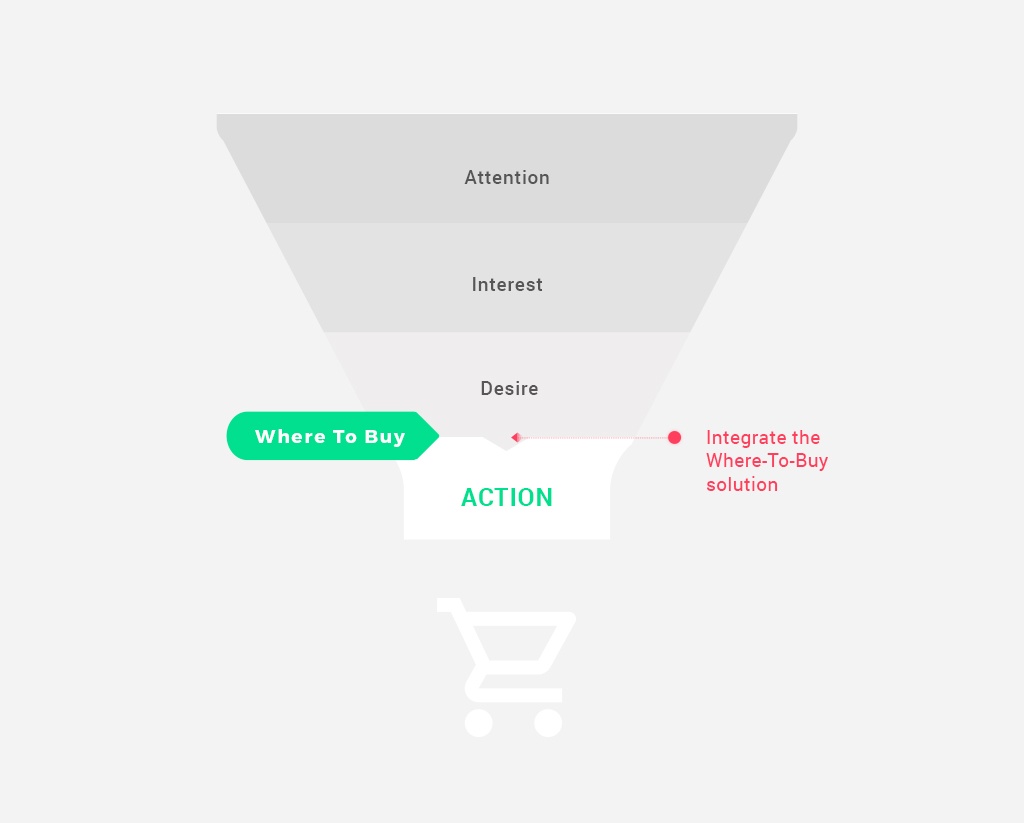Sales funnel is a sales process that is divided into several stages. The aim of every stage is to influence the behavior of the potential customer in a way that they reach the bottom end of the funnel, that is – make the purchase. Sales theory operates with a few sales funnel models, with the number of stages varying between 4, 5, or even 6. But whichever funnel model is applied in your sales process, the number 1 approach to effective sales is employing tools that will incrementally, but inevitably drive the customers straight to the checkout. One of such silver bullets is the Where-To-Buy solution.

Having a too complicated sales path might increase the drop off rate and foster cart abandonment rates. Customers could be drifting away to your competition, whose sales processes have been made more palatable. Shoppers are now expert at researching and comparing internet offers on products, which are eventually purchased both through the online channel and traditionally, in-store. The new Deloitte report, Navigating the new digital divide. The influence of digital tools on shopping habits in Poland, 2019, shows that 20% of the respondents browse for information about products directly on producer’s website. In that light, turning your website into a platform effectively funneling potential shoppers down the desired sales path is the way to go. What does that mean in practice?
The structure of the sales funnel
An average sales funnel inevitably rests on the AIDA model, a simple template which helps to adjust our marketing efforts to individual stages of the selling process. The top end of the funnel is much wider than the bottom one, as it accommodates all leads, all potential buyers who don’t yet realize they are a good fit for what we sell. Labeled Attention, that tier illustrates the target audience whose attention we’ve managed to capture. From that point down, our outreach strategy must be designed to raise buyers’ Interest, and then to spark Desire for our product. The bottom end of the funnel consists in Action, that is – the purchase.
The working knowledge of the sales path processes makes it natural for brands to allocate a firm place on their website for a where to buy solution. As mentioned above, 20% of the respondents commence their search for a product on producer’s website. As much as 48% browse for information about products online. Brands view the customer’s visit to their site as a direct signal that the lead has already gone through both the first and second stage of the sales funnel. Either the interest of the potential buyer in our product is already elevated, or their desire for our goods has now been triggered. Therefore, using the brand’s website to further facilitate the purchase seems an open and shut concern.
Where-To-Buy as a Call To Action
By integrating the where to buy tool with your website, you can send a message that is simple and clear – our goods can be purchased from one of the official outlets listed below, at a specific price. What you’ll also be communicating is that all the products will arrive on customers’ doorstep through the official channels of distribution. Secondly, that all the goods are under manufacturer’s warranty. And finally, that buying with you simply equals choosing the finest quality. What is more, the where to buy solution also lets you drive traffic both to an online store and the selected brick-and-mortar points, an essential alternative for customers who prefer to shop offline.
The where to buy tool is effective in inspiring action precisely because clients can find all the necessary information directly on the website. This greatly simplifies the choice as to the retailer. If further assistance should be required, the customers could always resort to a dedicated helpline, where customer service agents would assuage their concerns. If a visitor pops up in your website traffic tracking tool right in the middle of the sales funnel, they must already be a stoked lead, a potential client extremely eager to make the purchase. If such a keen visitor is ignored, they might easily drop off the funnel. Such an out-turn must naturally be avoided at all costs. The loophole in the funnel can be closed with a Where-To-Buy tool.
In-depth data analysis facilitates a long-term strategy
The Where-To-Buy plugin allows us to track and analyze the behavior of visitors to our website. That feature lets us adjust the content and communication specifically to their needs. With an access to specific data, we can sneak a peek at supply levels that specific distributors and retailers are running on our goods. We can also quickly learn which outlets would soon have to be re-stocked, and what the real inventory figures and selling prices are. This allows us to steer our clients to the shops which offer the most adequate supplies of the selected merchandise, together with the most affordable prices. It’s important to stress, however, that the price gaps here will be pretty narrow, as the products are sold through the official channels of distribution. Too wide a price gap in different shops might lead to a price war, which would surely be uncalled for.
Smart application of suitable tools shouldn’t be underestimated in managing website traffic, as it shouldn’t be on the individual stages of the sales funnel. Naturally, abiding by one solution would provide a too narrow perspective on our business, therefore a wider array of instruments is recommended. Content marketing, customer service center, contextual marketing, together with many others, will definitely deliver much better results. The upshot will be reflected in the analysis of user experience and their expectations towards our brand, in their price sensitivity, and reaction to other factors which influence the sales of goods and services.








